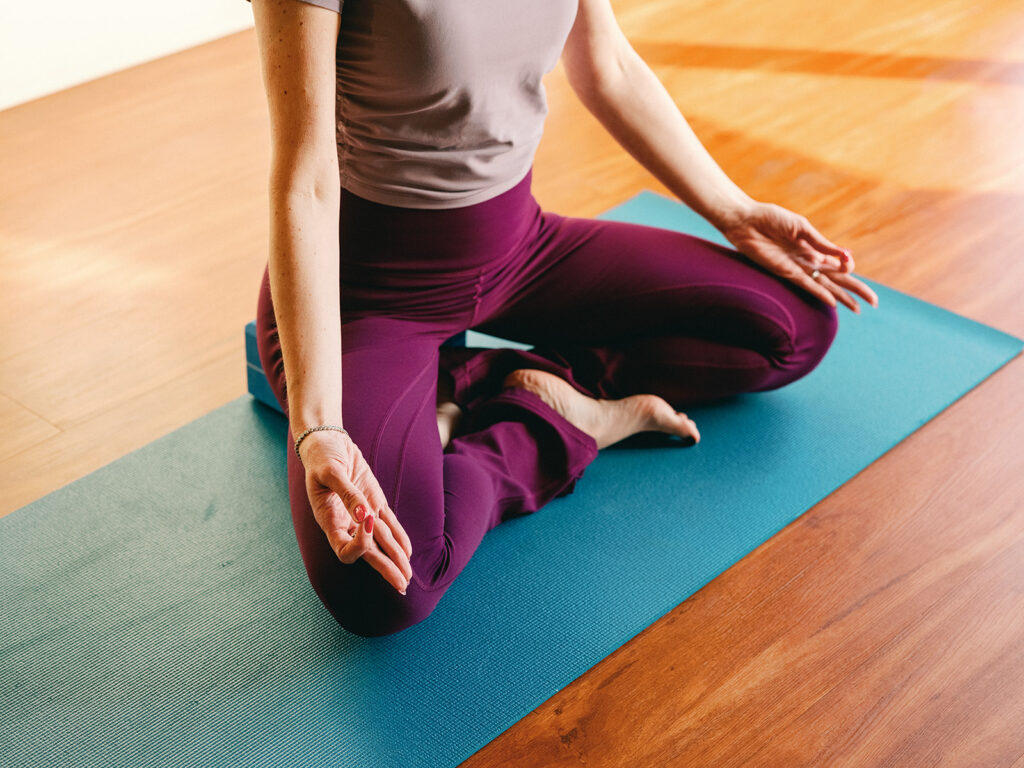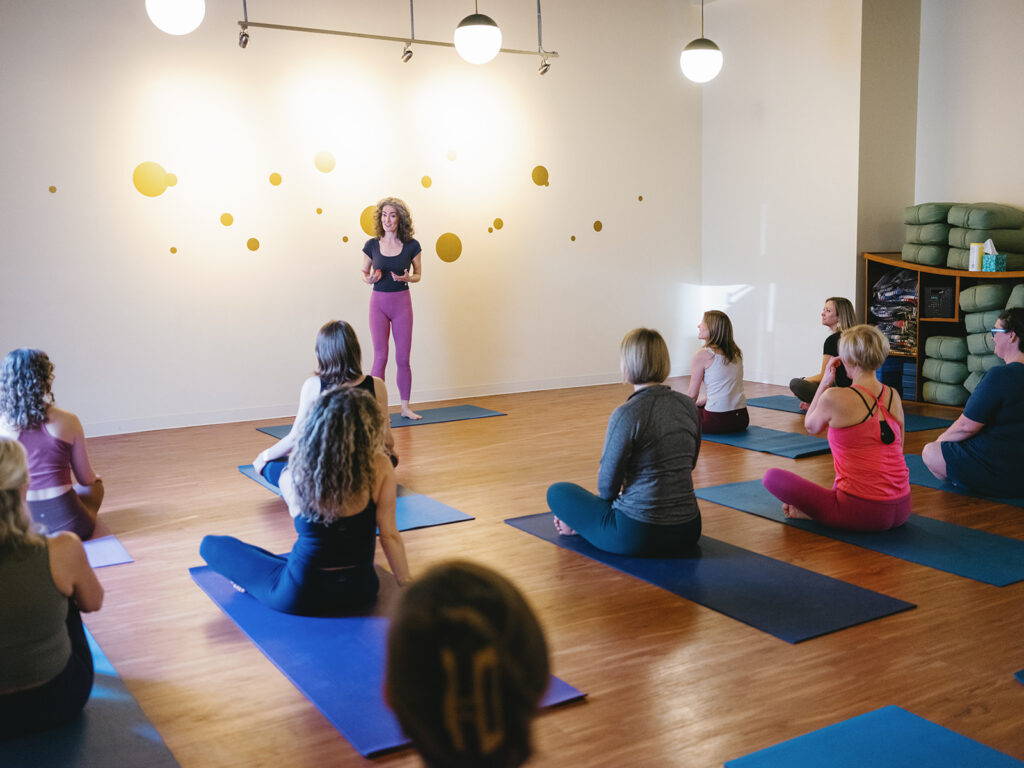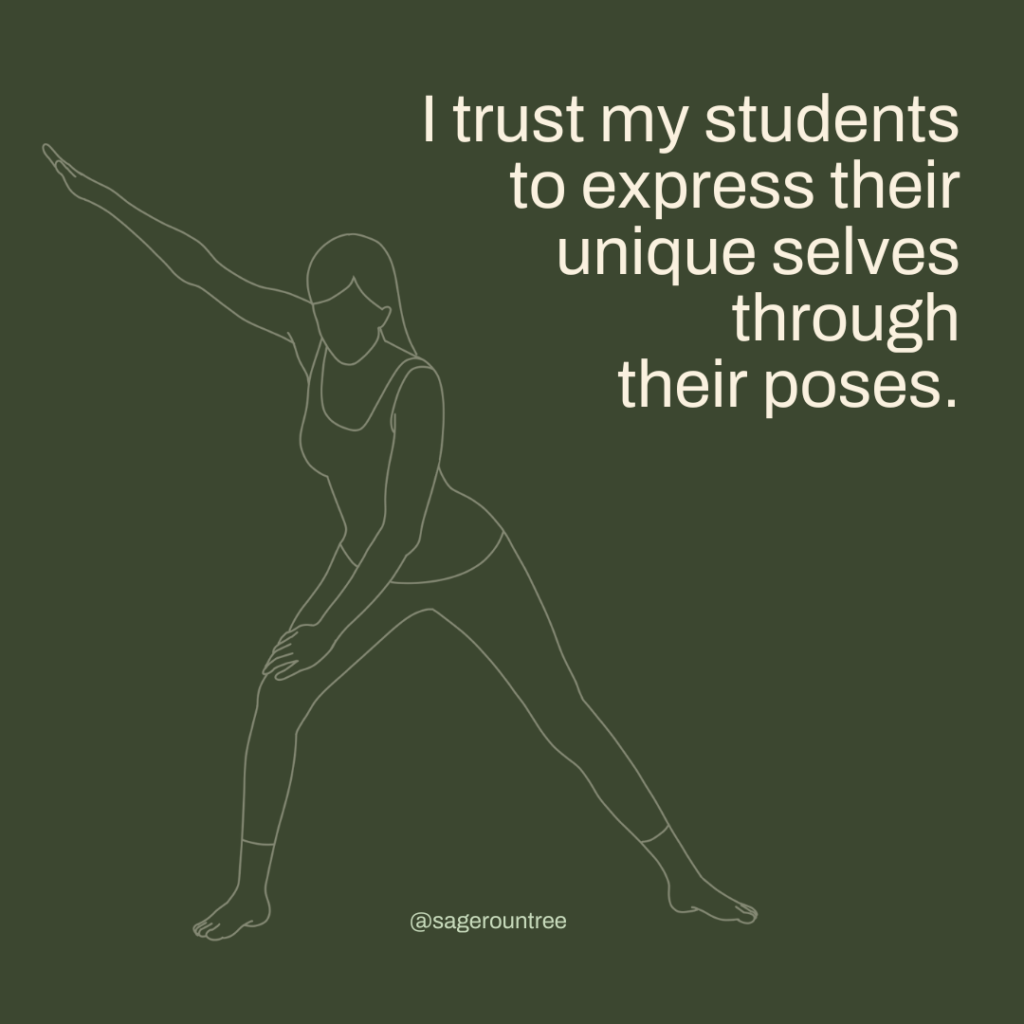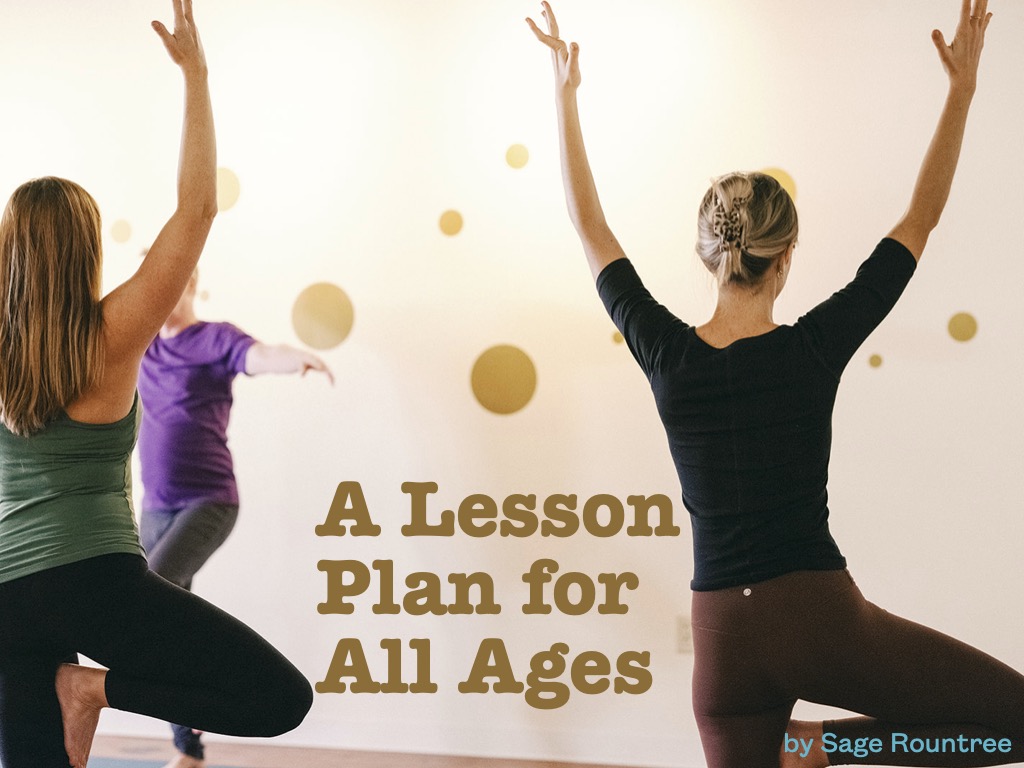how to become a better yoga teacher: center your students, not yourself
Your yoga teacher training might have unintentionally set you up to feel like the hero, not the guide, in yoga class.
And seeing yourself as the hero might be messing with the very thing you got into teaching yoga to achieve: helping your students find connection, union, with yoga.

Your students come into your class—understandably—each with their own main character energy. Make sure you’re honoring their experience as main characters and centering their agency.
That means supporting them as a guide, not positioning yourself as the hero of the classroom. When you center your students’ agency, you:
- Encourage each student to find their own best expression of each pose
- Do not impose your own will and biases on your students’ experience in class
- Allow your students to learn by doing and not simply by mimicking
And as a result, your students will develop their own relationship with yoga faster. They will more quickly achieve the connection, healing, balance, recovery, or whatever they came to class to find.
In fact, students are more likely to return to your class when it is a space where they feel seen, centered, and included—where they feel like heroes.
You started teaching yoga to help others. You’ve spent hundreds of hours—and thousands of dollars—on training to improve your skills. But here’s what you might not have learned: you’re not the hero of your yoga class. Your students are.
The minute you stop thinking your yoga class is about you, everything changes—for your students and your career. When you center your students’ agency, teaching becomes easier for you and more meaningful for them.
Here’s how to shift your mindset by clearly seeing what your job is as a teacher, and how to serve your students best by recognizing and prioritizing their main character energy.

the yoga teacher’s role: guide, not hero
You are not the hero, your client is. You are the guide. Every single student in that room comes in with main character energy! Your role is to support them in their heroes’ journeys—not to hog the limelight. You aren’t Luke Skywalker—you’re Obi-Wan Kenobi (or Yoda!). You’re not Frodo, you’re Gandalf. To put it in terms of the yoga mythologies, you’re not Ram, you’re Hanuman. You’re not Shiva, you’re Durga. You’re not Arjuna, you’re channeling Krishna.
When you adopt this perspective, you are centering students’ agency. Student agency means allowing your students to take control of their own practice. It’s about giving them the tools and space to make choices about what feels right for their bodies, rather than directing them toward a specific outcome. This is how you make your yoga classroom inclusive. And with this worldview, the yoga practice you guide naturally becomes accessible yoga.
Once you center your students, you get really interested in exactly how you can help them on their own heroes’ journeys. This enthusiasm for being the best possible guide will lead you to develop specialized programs that will help your students, the heroes, fulfill their quests and create their own happily ever after. Often, this happens outside the regular weekly class. Instead, it takes place in private lessons, workshops, and retreats. In these settings, you can better guide deep changes in your students. (Yoda didn’t show up to Luke’s house once a week to teach him how to use the Force! They went away to a secret planet for a long time.)
When you embrace this perspective shift and center your students, you’ll find yourself brimming with ideas for ways you can help heroes along their journeys. And you’ll spend a lot less time, effort, and struggle trying to position yourself as a hero. That was never your job in the first place.
And at worst, you might find yourself turning into an anti-hero. You can’t move your students toward yoga—union, connection—with anti-hero energy.
are you the anti-hero?
Modern Western posture-focused visual yoga culture—and even your 200-hour yoga teacher training—may have unintentionally contributed to the illusion that you are the hero in the classroom. It might even have built you into an anti-hero: someone who focuses on the wrong things, even if they do so in appealing ways. A yoga anti-hero feels like they need to:
- Draw attention to themselves, especially on social media, with flashy imagery
- Create exciting new sequences each week
- Wedge philosophy into their class to prove their knowledge and impress their students
- Talk incessantly—again, to prove how wise they are
- Cut down their colleagues in an attempt to get ahead
- Obsess about their class numbers as though students are a depletable resource
- Hustle, hustle, hustle! Sell, sell, sell!
The anti-hero teacher believes their way is the right way, possibly the only way, to practice. They ignore their students’ agency and let their own wrong-seeing (avidya) control their classes and their career. They let ego (asmita) and fear of loss (dvesha) cloud their vision of how they should conduct themselves.
I know this because I used to be an anti-hero teacher. I wanted students to do things my way! I had an idea of exactly how students should be executing every pose. I thought success was looking out and seeing everyone in “perfect” alignment, because my careful cues had landed so well. I used to have nightmares about students not following directions in class. (OK, I still do. And in these bad dreams, I yell—loudly—at the students for not toeing the line.)
I wound up creating a chaotic, exclusionary classroom, because I let my ideas come first.
Somewhere along the way, my own yoga practice kicked in and started offering clarity. It helped me realize I was seeing things wrong. It was not my job to make my students do anything at all. It was my job to throw out some suggestions, remind them that they are the boss—not me—and then let things be, without needing to change anything.
And that’s how, after 20 years of teaching yoga, I recently found myself leading a 60-minute yin class where one student never moved from the first shape, a supported backbend with lots of props. This would have completely flummoxed the old, anti-hero me. But the guide I have become knew what to do: check in with her—was she breathing? Was she conscious? And beyond that, I recognized and celebrated that she was following her practice where it took her. And I trusted she knew better than I did exactly what she needed from her yoga.
Now when I look out and see everyone in the room doing something different, I know that is success. It means each student is leaning in to their own main character energy. Each student is following each pose where it leads their body. It takes a big leap to let go of your need for control—your anti-heroic need to be the hero—and to acknowledge your students’ agency. But it’s a leap worth taking. The net will appear.
If you worry you may be an anti-hero teacher, it’s not too late to change. You just need to turn to your own yoga practice and start seeing yourself, and your role, clearly.
the problem: wrongly seeing your role as a yoga teacher
Yoga teaches us that there are five kleshas, or causes of suffering: avidya (ignorance), asmita (ego), raga (attachment), dvesha (aversion), and abhinivesha (fear of loss). They represent the obstacles to clarity and connection, clouding our perception of ourselves and others.
The root of all of the kleshas is avidya, wrong-seeing. When our perception is clouded, everything we do emanates from a place of confusion, and our actions move us toward disconnection instead of connection, union, and yoga. Wrong-seeing causes suffering.
The other kleshas also contribute to this suffering for you as a yoga teacher. If you’ve ever struggled with an attachment to ego (asmita), craving material success (raga), fearing failure as a teacher (dvesha), or worry about your legacy (abhinivesha), you’ve suffered from the effects of wrongly seeing your position relative to your students.
You need to see your role as a yoga teacher clearly, so that you can avoid suffering and better share the gifts of yoga. This includes knowing your scope of practice. But most importantly, it’s to know exactly what your job is.
Your job as a yoga teacher is not to be the hero. It’s to be the guide.
a new way forward for your yoga teaching
Everything changes when you center your students over yourself. By positioning your students as the heroes and yourself as the guide, you will naturally create inclusive, adaptable classes.
By putting your students first, you’ll avoid much of the suffering that might otherwise come your way in your career teaching yoga. And as the Sutras tell us, the suffering that is to come can be avoided. Right-seeing of your role is the path.
Here are just some of the ways you’ll find more ease once you realize it’s not about you:
less emphasis on alignment
When you center your students’ agency, you recognize they hold veto power over any of your cues. If something feels right for them, they will do it. If it doesn’t, they won’t. Part of being a good guide is letting your students find their own way. That might even involve learning by failing. (It’d be a pretty boring story if the guide imparted wisdom, the student followed it immediately with no mistakes, and everything came out great!)
When the students are the heroes, you won’t micromanage their poses. That means alignment doesn’t matter much. Once you aren’t thinking about imposing your will on your students’ bodies, you’ll have so much more time to say really helpful and inspiring things in class. You won’t beat yourself up if students aren’t “getting” your cues—because there’s nothing to get.
When the students are the heroes, you’re no longer buying in to outdated alignment models, but instead seeing your students for the unique individuals they are and teaching them accordingly. You might offer them suggestions for greater comfort, but you don’t force them into any particular expression of a pose.
no need for manual assists
As a corollary to releasing a need to control alignment, by centering your students’ agency, you won’t need to worry about manual assists and adjustments. When you accept that your students can and should make their own choices, you won’t try to push them into a particular shape manually.
Rendering assists irrelevant makes your classroom a safer place to be, both physically and emotionally.
Physically, you will avoid injuring your students. While the intention behind most assists is usually good (let me help you get deeper/feel better/see what’s possible), the actuality is that it’s too easy to do harm rather than help. A poorly administered assist can be confusing, and at its worst can cause injury. And keeping track of what assists to offer to which students can use up your energy that could otherwise be devoted to providing a good experience to everyone in the room at the same time.
Emotionally, skipping assists means you don’t need to navigate the tricky situations of expressed consent and favoritism. Not touching your students makes your classroom more trauma-sensitive. It takes a lot of time and energy to get students’ consent for every optional assist; skipping assists in general frees up this time and energy. And giving assists to only some students can read as favoritism (or worse, as predatory).
If you’re used to offering manual assists in yoga class, what will you do instead? Empower your students to make their own choices! Use verbal cues and a range of options, including using props both to make poses sweeter and also to make the experience spicier.
don’t ask about injuries
If you ask your students about injuries, you’re likely doing so out of a desire to keep them safe. But that’s not your job! Even if you are a physical therapist, nurse, or doctor, it’s outside of the role of a yoga teacher (and outside the bounds of your liability insurance!) to provide medical advice in the context of a yoga class. And once you are aware of injuries, you have a duty to do your best to avoid making them worse. This article by lawyer and yogi Gary Kissiah will help you understand the ins and outs.
When you remember your students are the heroes and recognize that each student is in charge of making their own choices, you keep them safer by not taking on responsibility for their injuries. Your role is simply to remind them of their own agency. You’ll encourage them to listen to their bodies, make wise choices, and avoid things that don’t feel right.
simpler is better
Once you center your students in your planning, and not your own need to prove your creativity, you won’t belabor your sequencing. There’s no need for sophisticated choreography! Your students need regular, repetitive consistency, so they can really get to know the shapes and the concepts of yoga in order to develop a broad base for a lifelong yoga practice. (For more on why consistency is critical both physiologically and psychologically, please read these blog posts on why consistency matters and how to be consistent in your yoga class lesson plans.)
When you keep what’s best for your students ranking over what’s good for your ego or attention span, you’ll be a better, more helpful yoga teacher. And you’ll not only serve your students better, but you will also create a sustainable, long-term career for yourself.
and it’s easier on YOU
This means you have SO much less to think about in class! You don’t have to memorize a fresh sequence, nail the timing, remember all the modifications and contraindications for injuries, or otherwise tie yourself in knots. Instead, you’ll show up and teach the students who are there, remembering that you are serving as a guide. Again: they are the hero, not you.
When you make things easier on yourself in class, your energy shifts in wonderful ways. You’ll be a calm, centered guide. You’ll have more headspace and energy to say helpful things, and less need to frantically manage the room. Your students will notice. They will soak up your calm energy. They will feel the benefits of their practice quicker and more directly. Everyone wins.
you’ll find freedom
A whole new world of possibility opens up to you as you adjust your thinking to center your students and decenter yourself.
You can teach online to students with their cameras off! Heck, you can teach via on-demand video asynchronously! When you drop the need to control your students’ experience, and you aren’t there to make anything in particular happen, your service to your students’ union can go in a wide range of directions.
Private lessons will be a joy to teach—not a scary burden—because you get to work one-on-one as the guide to get the hero where they want to be. Workshops will be easy to plan and sell. Retreats will become an exciting way for you to guide your students toward yoga.
Your messaging around your class will change for the better, too.
Forget the need to post yourself doing showy yoga poses in glamorous locations: it’s not about you! Show your students the transformation they can expect.
Forget the need to run all around town to different studios trying to develop and spread your brand: it’s not about you! Find the students who need you most and help them where they are. It might not be at a studio at all.
Forget the need to constantly sell your classes, workshops, and retreats by talking about yourself and how special you are: it’s not about you! It’s about how special your students are, and the problems you can help them solve. Maximize your impact by sharing what you’ve learned overcoming your own struggles. Be a wise guide.
Let your messaging focus on the hero, and the tools they will gain by practicing with a wise guide. Tell your students the transformation they can expect. Show them how yoga can solve their problems and ease their pain. Deliver ways to help them along their heroes’ journeys.
This mindset will be a huge boost for your career, as you will find new ways to earn money while helping students better.
and best of all, you’ll feel confident

Most of all, you feel confident because it’s not about you. You are merely a vessel for the magic of yoga to channel through.
With this attitude, you can say goodbye to imposter syndrome. Even if you’re not feeling like Obi-Wan or Yoda or Gandalf, it doesn’t matter, because it’s not about you!
You don’t need to know it all. You just need to know a little. You only need to know what direction to point the hero in. Then the hero will embark on their own journey.
This is such good news! This is how you shift your attitude toward easy class planning, toward developing new problem-solving programming, toward building a sustainable, rewarding career that changes lives—starting with yours.
You remember it’s not about you. It’s about your students.
let me guide you
By now, I hope you see—and agree—that you are not the hero in your classroom.
But you are the hero in building your career. Your quest is to create a sustainable set of systems and skills that lets you become the best possible guide to your students.
My role is to be a guide’s guide. It’s very meta! I’m here to help you keep your focus where it belongs: on your students. I offer ways you can improve your skill inside the classroom to help your heroes better. And I can help you develop your professional skills outside of the classroom to build healthy relationships with money, with your colleagues, with your employers, with the law, and with your career.
If you want to be the best guide you can be, let’s connect. Here are some ways we can work together:
- Read my books for fresh perspectives on teaching from a student-first perspective
- Listen to Yoga Teacher Confidential for candid advice on overcoming common teaching hurdles
- Join my YouTube channel for tips on how to teach yoga better and inspiration for your sequencing
- Take an advanced training course to deepen your knowledge and strengthen your teaching
Meanwhile, please let me be your guide in planning your next class. Pop your email in the form here and I’ll send you my go-to back-pocket lesson plan that works for almost every student, along with cues to remind them of their agency to make the practice what they need to achieve yoga.
let me plan your next yoga class

Feeling uninspired when it’s time to plan? I’m here to help!
Give me your email and I’ll send you my go-to yoga lesson plan with ideas for every minute. This is the class I teach when my energy is low—but it’s the favorite of my students from 20 to 80 years old! I’ll even give you tips on how to adapt it for various class formats.
